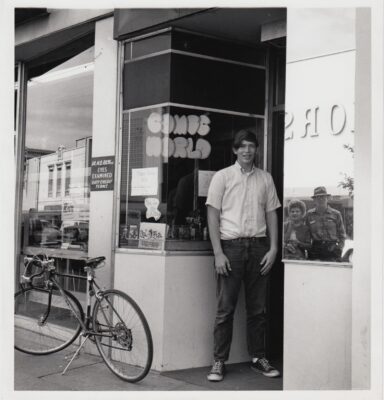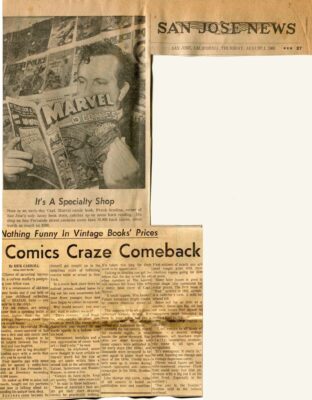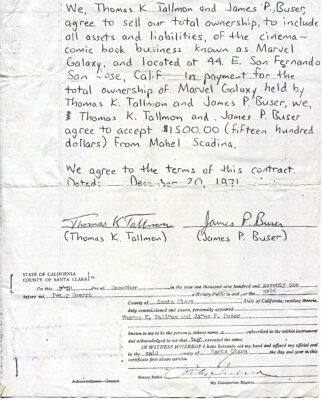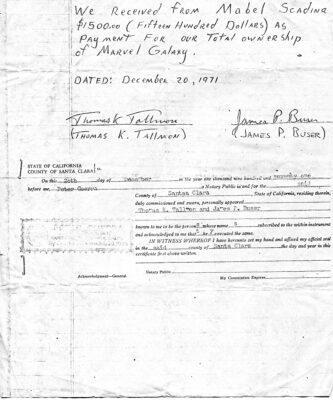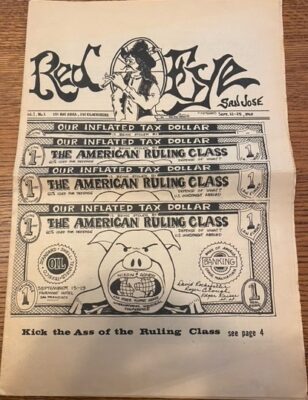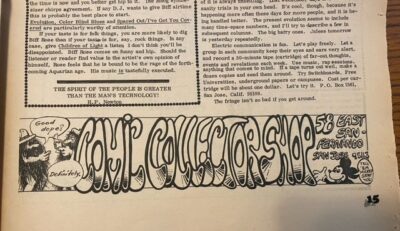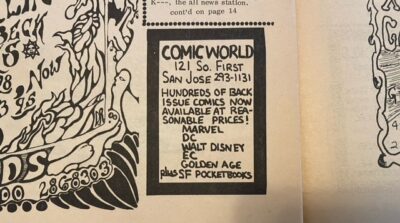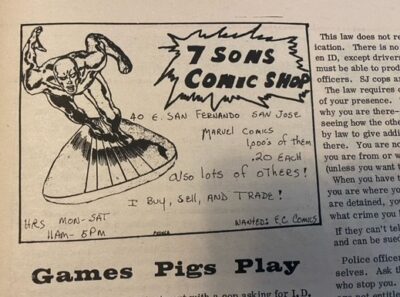Pre-history of Comics and Comix Co. by Bud Plant & Jim Buser
From Bud Plant:
Comics & Comix is today considered the first, or at least one of the very first, multiple-comics-store operations. Begun as one store in Berkeley in 1972, it was four stores by 1974, thanks in part to buying the Tom Reilly/San Francisco pedigree collection as a result of the Berkeley Con that we put on along with Mike Manyak and Nick Marcus in 1973. By 1988 we had seven stores and they were doing $2 million in gross sales, but were in fact losing money due to excess inventory, the high cost of personel and overhead, and other issues. John took his share and left to start his own store in Santa Rosa. I bought out the other minority partners, and then sold the chain to the Financial Controller of my company, Bud Plant, Inc. Mark Crittendon got it back on its feet and ran it until 1996. He then sold it out to Ross Rojeck. It was down to two stores by 2004 when Ross closed the doors. Still, 32 years, not a bad run, through thick and thin.
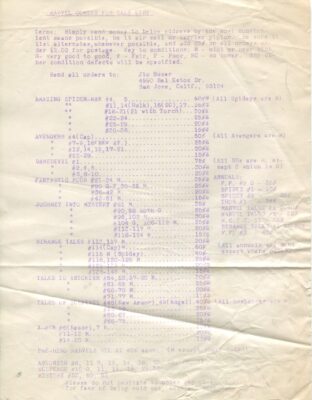
But first, Seven Sons Comic Shop was the very primitive version of what was to come. This was six collectors pooling $35 each and renting a small downtown store in San Jose, in March of 1968. This was one month before Gary Arlington opened the fabled San Francisco Comic Book Company.
And the funny thing was, our first store pretty directly led to San Jose boasting three stores just 15 months later. As Jim Buser details below, the five partners sold out their shares in the first store to the sixth (and oldest) partner, Frank Scadina. We didn’t really have a seventh, Seven Sons just sounded better than Six Sons. The other partners were John Barrett, Jim Buser, Tom Tallmon, Mike (Michelle) Nolan and Bud Plant.
Jim Buser insert:
First, some background on how and why Frank Scadina bought the rest of us out of Seven Sons. After our initial launch on March 1st 1968, biz was unspectacular but steady enough. By mid-summer, however, it started to peter out. We’ll never know if Frank was pocketing any money, but we do know that he pulled a fast one on us. At some point a reporter from the San Jose Mercury came into the store while Frank alone was running it, and said he wanted to do a feature article on the fledgling new store. Frank hatched a plan. He told the reporter to come back in a few weeks. In the meanwhile Frank got his mom to make us all a buy out offer that seemed like a good price, given how business was slumping. (I don’t remember what the price was.) Anyway, we all snapped at it, and within days the Mercury ran the attached article. Not surprisingly, business then skyrocketed for Frank!
Frank was not the sharpest blade in the drawer, and he had one particular weakness that meshed poorly with that shortcoming: he was a compulsive gambler and a lousy one at that. He was the kind of poker player who would love to draw for the inside straight, just for the excitement, even if the odds were against him. One night (I think sometime in 1971) Frank got into an all night poker game with Tom Tallmon and me. By dawn, Frank had literally gambled away half ownership of his store! (I think Tom won something like 30% and I won 20%, but I compensated Tom something to make us equal 25% partners. Again, my memory is hazy.) So for months, Tom and I were back in the game at Marvel Galaxy located at 44 East San Fernando Ave. However, once again, Frank’s mom came to the rescue. In late December 1971, she bought Tom and I out for $750 each, giving Frank again full ownership of a store. (See the attached notarized buy out agreement.) Can you imagine a quarter interest of a comic store going for that now??
Back to Bud Plant:
Then Frank skinned Bob Sidebottom for an early issue of All Star Comics and a couple other Golden Age, paying less than $10 for the bunch. I remember a $5 figure for all of them.
Bob had found these at the San Jose Flea Market. Comics back then at the flea market sold for a base of five cents each; maybe someone got a little more out of Bob, but surely not more than a dollar or so, more like .25 each or something.
Bob collected records at the time and worked in a record store on Stevens Creek Blvd. in San Jose. The story is he started hanging around the store a bit, shooting the shit with Frank, since they both had lots of time on their hands. Frank proceeded to brag to Bob what a sweet deal it was to have a comic shop — remember this is circa 1968-69. No price guide, so comics (and pulps) would come in the door and people were thrilled to sell them for five cents, ten cents, a quarter each at the most. Comics still only sold for .12 each new, .rising to .15 cents in 1969. Annuals cost 25 cents.
We were friends with Bob and Frank both and also hung out in both stores, swapping comics, playing cards, swapping news and comics lore. The story goes that Bob said, “If this bozo can do this (Frank was not the brightest guy around, sadly), I can do it and maybe better.”
So he did. Bob first opened up a used comics and record shop about 20 blocks east of downtown where Frank was. It was in a “bad” section, but the rent was cheap. Frank freaked out, but we, in all honesty, told him not to worry. It was a very poor location, and people were not going to travel there to buy their comics.
However, Bob wised up quickly, relocated a block from our original location and Frank’s store, in a far nicer store. This also put him across the street from the long-lived and widely known Twice Read Books, as well as a liquor store that had several spinner racks of new comics, as well as magazines and paperbacks. There was another larger such store, The Humador, just two blocks away.
Not one of these stores were yet selling new comics, just older and recent stuff that would come in the door, or could be found at yard sales and the flea market. Twice Read Books (aka Woodruff and Thrush) was the used book shop where I first met a collector who introduced me to Barrett, Buser & all the other San Jose collectors, who already knew about fanzines and fandom, while I did not. And all of this was just 4 blocks from San Jose State, with 25,000 students, where I got my undergraduate degree. It was a choice location for hip stores like ours.
Bob proceeded to do a far better job than Frank, even with his own faults. Frank changed the store name to Marvel Galaxy and expanded into movie stills and posters, and new magazines like Cinefantastique, Cinefex, Steranko’s Mediascene, etc. He often stiffed his suppliers. And he moved down onto First street, a couple blocks away, with two movie theatres nearby and a 3rd on South Second Street.
In 1974, when we opened the Comics and Comix store back in our home town again, we did it on South Second Street. We built in a sub-store inside devoted to solely to Star Trek. It was a huge furniture store and we could not fill it with material (by this time we did sell new comics, new sci fi paperbacks, magazines, fanzines and books about comics. So we contracted with a local supplier to put in 2 pool tables and 8 or 10 pin-ball machines in half of the store. We’d split the take, in dimes and quarters, once every week, and more than pay for the space.
But back to 1969:
John Barrett, Jim Buser, Dick Swan (who after his C&C tenture would become Big Guy’s Comics, first brick and mortar store, then an ebay seller) and I drove to Houston Con in 1969, our first comics show. We’d only previous been to the Berkeley/Oakland Worldcon Science Fiction Convention in ‘68 up until then. But as novice dealers, we always set up and sold comics at both these shows. In Berkeley, four of us shared an eight foot table. We did the same at the first San Diego Comic-Con in 1970.
Back to Houston, however. At the end of the show, the four of us bought out at least one guy’s table or tables, maybe even another fan/dealer or two… We piled the comics into the back seat (between us, in a Ford 4-door) and jammed the trunk so full they fell out when we were stopped at the Calif border to check for contraband.
On the way home, we four decided to open our second shop.
We certainly didn’t think about a non-competition agreement when Frank’s mother bought us out in ‘68, and neither did they. So just about one year after we sold out our shares (except for Dick, who hadn’t been part of Seven Sons), we opened in June of 1969 at 121 South First Street, a block from Frank’s store, two blocks from Bob’s. The former store Bead World, had left their exterior sign up and moved next door into a former jewelry store. Being the practical youngsters we were were (in 1969, Dick was 16, Jim and I were 17, and John was 18)—we just painted COMICS over the word BEAD and had a new store name. It was a tiny location, a converted stairway for what used to be a hotel (the upper store was abandoned and we used go up and wander around from store to store, as well as play cards up there). You could touch both walls with your arms spread out. We sold used comics, used sf paperbacks and used LPs for the next 13 months or so.
But…that was how we ended up with 3 stores in San Jose at the same time. Meanwhile the far larger San Francisco, 50 miles to the north, had just one, Gary Arlington’s San Francisco Comic Book Company. Gary had opened up in April 1968, just a month after Seven Sons opened in March. Berkeley had no stores, though Gary Carter told me recently he remembered a book store that had COMICS on their exterior marquee in Berkeley, but unbeknownst to us.
There was also a small store that handled comics among other things collectibles that was called Treasure Island, in a small mall up the peninsula north of San Jose, but it was not a 100% comic shop by any means.
We closed Comic World at the end of August 1970. I was starting my first year at the previously mentioned San Jose State (now California University San Jose). I had signed up for 18 units and could not imagine also running a store. John was also busy, starting year two of journalism degree.
John and I had already bought out Dick and Jim, since four partners was pretty ridiculous for such a tiny little store. Dick was now a senior in High School in 1970. Jim was starting year two at Stanford University on a sports scholarship.
But we’d all be back together in Comics and Comix before long.
John and I decided to open the first Comics and Comix store on Telegraph Ave. in Berkeley. Killer location, no other store in town, the huge University of California campus just four blocks up the street. And the focal point for the new drug culture, for underground comics, for flower power and all the hipness of the bay area.
We scouted out a location and John actually got a hit of tear gas while were were up there looking around, staying out of one of the small student riots going on. Amazingly, we found someone to rent us a real, honest to god decent sized store on Telegraph and Dwight Avenue and we opened in September, 1972.
I had started my mail order business in late 1970, in that same freshman year at San Jose State. John had helped out by filling orders for me in the summer of ‘71 and summer of ‘72, while he was off from college and I was off doing the comic conventions, including Houston, Dallas, and the New York shows. When I came back in 1972 from the shows, John was so impressed by my business (selling fanzines, underground comix, and books about comics, what few there were), that he proposed we re-up our old partnership. I countered with, let me keep my mail order gig, but let’s open another store. He was game to drop out of college so he could provide the labor, and I was doing well enough I could provide the starting capital and of course, lots of underground comix, zines and all the stuff I handled. We of course could now also sell all the new comics too. So I stayed in San Jose, going to school and running my mail order biz. John’s commute to Berkeley was 120 miles a day until he moved north to Oakland/Berkeley. He was a driving fool!
Meanwhile…..We had been running into Bob Beerbohm on the convention circuit since 1969 and we invited him to go to work for us, and maybe buy in as a partner. Counter to Bob’s own version of this tale, he did not come up with the idea of the store, he did not find our location, didn’t make the initial rent, and in fact left town to go back to Nebraska when we were opening the store.
Bob turned us down because he wanted to go back to Nebraska and go back to school. Sadly, on the way home, after the San Diego Con in August or early September, his engine blew up out in the hundred degree heat of the great Salt Lake in Utah, west of Salt Lake City. He holed up there and hired a fly by night gas station to rebuild his engine, but that used up all the money he had allocated for books and tuition. So he turned around and headed back to California. His car blew up AGAIN near Sacramento; I drove up with my van and towed him back to the house I was renting with two buddies in San Jose. The broken down car lived in front of the house until he sold it for scrap.
Bob started a part time local job while he also began commuting to Berkeley to work in John’s and my store. He eventually bought into the partnership and in fact spear-headed another store within a store, the “vintage comics & collectibles” room in the Telegraph Avenue store. He ran until the three of us broke up in 1975. Bob left to start his own store down the street in Berkeley, Best of Two Worlds.
I moved to Grass Valley in Spring 1975 with my new wife and my best friend since grade school, who also was my first employee. My goal was to be within an hour of the closest C&C store, and by then we had one in Sacramento and would soon open another in Citrus Heights, outside Sacramento. I’d run comix and undergrounds and all my stuff down to the stores once a week, where someone else would run a route with other stuff that would flow between the stores. But that’s another story….
more from Bud Plant here:
Join us for more discussion at our Facebook group
check out our CBH documentary videos on our CBH Youtube Channel
get some historic comic book shirts, pillows, etc at CBH Merchandise
check out our CBH Podcast available on Apple Podcasts, Google PlayerFM and Stitcher.
Use of images are not intended to infringe on copyright, but merely used for academic purpose.
Images used ©Their Respective Copyright Holders








